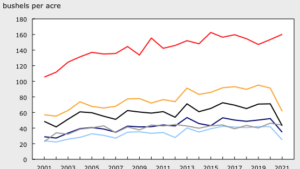There’s still a place for and renewed interest in non-GM corn and soybeans among farmers, seed growers and retailers.
It might be an exaggeration to call it a comeback, but there appears to be a renewed sense of interest in non-genetically modified soybeans among farmers and seed growers in this country.
According to data from Statistics Canada, non-GM soybean production in Canada totaled 1.44 million metric tonnes in 2017. Although that number represents a decline of 9.6 per cent from the year before, it stacks up favourably to totals from the early and mid-2000s, when production was slightly below 1.4 million tonnes for several of those years.
While GM-traited soybeans still account for about 80 per cent of the soybeans grown in Canada, a growing number of Canadian farmers have started looking at conventional soy as another option, drawn in part by higher premiums and growing export opportunities. In 2017, conventional soybeans accounted for $896 million in export sales. The majority of those shipments ended up in Japan, China and a number of other Asian markets including Malaysia, Vietnam, Thailand and Taiwan.

Ron Davidson, executive director of Soy Canada, says that even though non-GM soybean as a percentage of Canada’s total soybean crop has dropped in recent years, that is largely due to increased production of GM soybeans in Western Canada and advances in genetically modified products that have led to much bigger yields.
And that, according to Davidson, is one of the biggest challenges when it comes to growing Canada’s conventional soybean market.
“One of the challenges that we’re facing as the GM varieties continue to increase in yield is that we have to have new varieties coming out of the non-GM side or the premium has to go up,” he says.
“We explain this to our customers regularly because the importers abroad get used to certain varieties for their tofu or soy milk and they don’t like to change varieties. We explain that over the long-term, unless you want to continue paying higher premiums, you need to start looking at some of the new non-GM varieties that offer a higher yield and are more competitive with the GM crop.”
As part of that, Davidson says Canada needs to look at additional testing of non-GM products that focuses on taste and texture to increase the confidence of buyers in markets like Japan, the single largest importer of Canadian non-GM soybeans.
The vast majority of non-GM soybeans produced in Canada are currently grown in two provinces: Ontario and Quebec. Although soybean production in Western Canada has experienced a major boom in the last decade, it’s largely been on the GM side of things because of low protein content in soy in the west. Soy Canada is leading a dialogue with researchers, private breeders and seed growers that it hopes will eventually address the issue.
Davidson says Soy Canada sees there being room for growth when it comes to non-GM soybean production in this country. As part of a strategic plan the organization developed in 2016-17, it has targeted an increase of 25 per cent in non-GM production by 2026 as part of an overall goal of doubling soybean production during the next decade.
“The market is simply not as big (on the non-GM side), but we do see it continuing to increase because there is a consumer demand there, even domestically,” he says.
IP Program Gets Top Marks
When it comes to non-GM soybean exports, Canada’s two main rivals are the U.S. and Australia. So what makes Canadian soy an attractive option for buyers like Japan and Taiwan, where Canada is the No. 1 supplier of non-GM soybeans?
Of course, taste and quality are two primary considerations. So too is the country’s Canadian Identity Preserved Recognition System (CIPRS), which has been called the best IP program for non-GM soybeans in the world by no less an authority than Neoh Soon Bin, managing director of the Soon Soon Group, a Malaysian-based flour and oilseed processing company.
CIPRS is simple in its goal, but complex in its execution. The voluntary system was adopted in Canada in 2004 and is administered by the Canadian Grain Commission (CGC). In essence, CIPRS tracks soybeans from the time the seed is planted by the farmer to when the grain it produces is delivered to a grain elevator, processed and shipped to buyers around the world.
As part of the process, companies looking to sell soybean internationally can apply for CIPRS certification. They must then document all procedures they undertake from the time seed is planted, keep clear and objective records, perform an internal audit and then take part in an external audit performed by the Canadian Seed Institute, which is accredited by the Canadian Grain Commission. Once all of these objectives are met, applicants are CIPRS-certified and authorized to use the CIPRS certification mark to market their products, on their shipping documents and on their bagged soybeans.
The CGC regularly reviews the system to ensure it continues to meet the needs of producers and buyers. In 2016, the commission in collaboration with Soy Canada reviewed all of its IP soybean protocols and meets with industry partners each year to ensure all protocols are up-to-date.

Non-GM Corn
While interest in conventional soybeans appears to be growing, evidence seems to suggest the same could be said of non-GM corn. A recent decline in commodity prices has prompted some farmers to start thinking about what they can do to raise a conventional crop and reduce their up-front costs, improving total return on investment (ROI), says Ron Wulfkuhle, head of seed for the Farmer’s Business Network, which connects more than 8,000 growers from around Canada and the U.S.
“With the change in commodity prices it’s really causing farmers to think about what they can do to raise a conventional crop (and) not have to pay all the money upfront,” Wulfkuhle says. “They’re saying, ‘If I don’t really need that trait, can I substitute either through scouting or tillage or herbicides or insecticides what I would be paying for in a trait fee?’ It’s being driven not by our chatter, but by the markets.”
Wulfkuhle says interest in non-GM corn appeared to ramp up a couple of years ago when some independent seed companies began adding conventional hybrids as part of their portfolio and is continuing to accelerate. More than 90 per cent of the farmers buying FBN’s F2F Genetics Network conventional hybrids planted only traited corn in recent years.
“A number of farmers have said, ‘I think it’s about time I picked a couple of fields or a couple of farms’ — depending on the size of their operation — ‘and give it a try so I get some experience should it be something I could do on my whole farm,'” he says. “While the acres may increase by only single digits in North America, I would suggest the number of farms will increase pretty dramatically in that they are trying just a little bit.”

Markets
So what does all this interest in non-GM corn and soybean mean for the seed market?
Potentially, quite a bit, according to FBN’s Wulfkuhle, the former head of Syngenta’s GreenLeaf Genetics. That could be especially true for smaller, independent seed sellers, he says.
“It’s a bit easier for smaller seed companies or new entrants like FBN to step in and service that market than if I’m an established seed business and I’m already receiving lots of revenue off of traited products,” he says.
Phil Bailey, eastern business manager for SeCan, the largest supplier of certified seed in Canada, says seed breeding and quality hold the key to the future of the non-GM market for farmers in this country. To that end, his company is investing heavily in research into conventional soybeans that will provide clear hilum and high protein levels that will be able to compete in Ontario and Quebec.
“What we’re looking for is to try and breed a soybean that’s going to give us competitive yields and still give us a protein level where it needs to be. There’s been some advances there and it’s exciting,” Bailey says. “There are some products coming that seem to be breaking that barrier.”
There could also be interest in those seed products overseas. In Ukraine, for example, there is growing interest in conventional soybeans among farmers in that country, Bailey notes. Ukraine could be a good match for Canadian soybean varieties as they have relative maturity schedules that match up well. A number of SeCan member companies have already begun running trials and commercializing products for use in Ukraine.
“The opportunity there is massive,” Bailey says. “The challenge in Ukraine is enforcement of intellectual property. You can sign a deal with someone and send your material over there and then find out it’s being grown on hundreds of thousands of acres but you’re not getting any return on your intellectual property.”
End Users and Consumers
The increased interest in non-GM soybean and corn could also be good news for end users like Ingredion Canada, which turns grains and other plant materials into value-added ingredients and biomaterial for food and beverage products.
The company began exploring the market for non-GM corn at its eastern Ontario plant, one of two Canadian facilities, back in 2015. It has since signed up a number of growers to participate in its True Trace program, which documents the corn all the way from the seed stage to when it’s transported to its plant. The non-GM corn is used in a host of products including sweeteners, salad dressing and specialty starches.
“Certainly the pace of change that is happening in the food industry right now is very much happening at an accelerated pace,” says Becca Hary, director of corporate communications for Ingredion Canada.
“The trend towards non-GMO ingredients in food also creates some opportunities. As we are seeing this trend and knowing it’s going to continue being something that end consumers are looking for, we have really aligned our company to be able to capitalize on that and be an enabler of innovation and different types of ingredients that will meet their needs.”
Tom Lynch, Ingredion’s field contracting agent in Canada, says seed growers will play an integral role in growing this segment of the agricultural sector.
“Obviously, [the goal] of any successful program like this is seed production,” he says, adding Ingredion is having ongoing discussions with several major seed companies to ensure there is a readily available supply of non-GM seed and find growers who are a good fit with his company’s goals and objectives.
—with files from Kari Belanger













